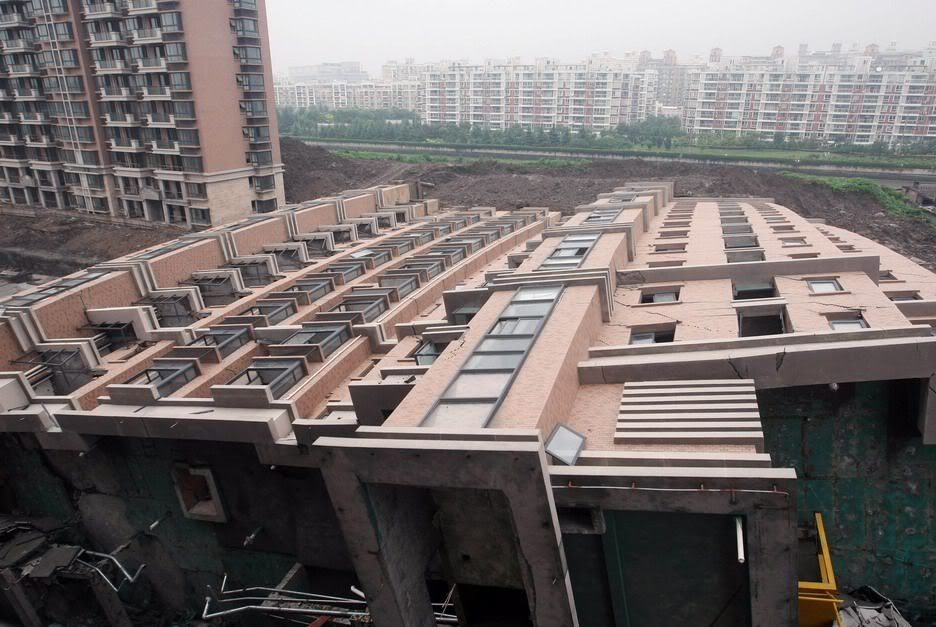
In China, cracks are appearing – in the neighbourhood of the massive Three Gorges Dam, the country’s great prestige project, and also in the Great Internet Firewall of China, enabling the ominous news to leak out. Three years ago stories were already emerging in the Chinese media about landslides, ecological deterioration and accumulation of algae further down the river. And less and less effort seems to be made to plug the leaks.
Recent media reports tell of a series of landslips, minor earthquakes and cracks appearing in roads and buildings along the central section of the Yangtse, between the dam and the city of Chongqing. Almost 10,000 “dangerous sites” have been identified, but many of the people living near them cannot be relocated for lack of money. Two years ago thousands of children died in Sichuan Province because their schools were not resistant to the earthquake which hit the area; in the town of Badong near Chongqing children are attending school in buildings which have been recognised as far more vulnerable. What else can they do? The local authorities can’t afford a new one.
Like many such megaprojects, the Three Gorges was always driven as much by politics as by economics. Its rationale covered irrigation and flood control in the lower Yangtse plain, hydroelectric power generation, which sounds sensible: but objections were bulldozed in the tense political atmosphere of the late 1980s, when the final decisions were made. The dam was the pet project of then prime minister Li Peng, who was involved in the party split which led to the 1989 Tiananmen massacre, in which he was the triumphant prime mover. In this context he was not going to back down on the dam, and the debate was closed down.
So the construction was forced through without even what passes in China for proper debate. The number of local people who had to be relocated came to 1.4 million – equivalent to the obliteration of Birmingham. Now it looks like another 300,000 will have to be shifted – add Coventry to that. This, in China, means getting a few weeks’ notice to quit and putting up with wherever the authorities see fit to put you. On top of that a large number of historic sites from one of the most ancient cradles of Chinese civilisation had to go. Yes, China has vast numbers of people to feed and cannot afford sentimentality, but perhaps a bit more care might have been taken to ensure that the costs and benefits had been properly calculated.
But even three years ago, with Li Peng and his family safely out of the way, official Chinese sources were admitting that things had gone horribly wrong. In the official media references were made to landslides, ecological deterioration and accumulation of algae. The Chinese aren’t unworldly and irresponsible greenies. When they point things like this out it’s because it’s causing real damage. Of course the authorities are careful not to promote mass panic, but so far the incidents are far enough apart to prevent collective protest; local complaints can still be suppressed without too much trouble.
Meanwhile, at the centre, it would appear that there is no great enthusiasm to see this all hushed up. The current supremo Hu Jintao has always taken care not to associate himself with the project. Hu’s faction of the Communist Party is broadly opposed by the “princelings’ faction” – i.e. the rich-kid offspring of the post-Mao leadership – and appears disinclined to pull Li Peng’s chestnuts out of the fire.
******************************************************
Built at a great cost, not only financially but in human suffering with the forced move of millions of people who lost their land and homes and for many their way of life with minimal compensation, I will be one of the first to say "I told you so".
Frankly, I worry for any large structure built in China due to so many issues related to graft and corruption and poor building regulations . Not long ago I posted a blog showing a high rise apartment building that just fell over..completely intact. Given that this is perhaps the largest engineering feat ever attempted, there were sure to be problems. A growing nation with a strong economy has a tremendous thirst for electrical power but the cost effectiveness of this venture is poor.
China has always loved the idea of enormous engineering feats, particularly dams. Sadly they don't care for them and maintain them properly after they're built. Environmentally dams flat out suck with a life span of only about 30 years before they silt up and become dangerous because sluice gate no longer can open. Their environmental impact both ecologically and in terms of CO2 emissions is staggering.
It's time that I blog in the near future about Banqiao Dam and the monumental loss of life and property that ensued in 1975. I suspect that few know of this and if nothing else it will educate those who think that dams are the answer.
Let me just say at this time that I have a friend in Harbin, Heilongjiang China who is a senior editor on the Harbin Daily newspaper. In discussing my fears for the new at that time about Three Gorges Dam I cited the Banqiao Dam disaster. (An educated woman with a master degree and she knew nothing about this disaster. I've learned that this is par for the course in China, where they are only taught the good things about the communist party.) According to the Hydrology Department of Henan Province, in the province, approximately 26,000 people died from flooding and another 145,000 died during subsequent epidemics and famine. In addition, about 5,960,000 buildings collapsed, and 11 million residents were affected. ..Rick
 13 story apartment building in Shanghai fell over in 2008
13 story apartment building in Shanghai fell over in 2008


No comments:
Post a Comment